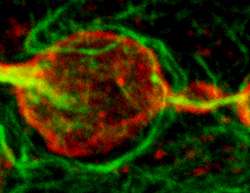Giant proteins determine properties of neurons

Giant membrane-associated proteins called ankyrins extend into the cytoplasm to arrange and stabilize microtubules in axons and synapses. This determines not only the diameter and hence the functional properties of axons, but also the size, function and stability of synapses. This mechanism underlying the control of neuronal dimensions, functional properties and connectivity was elucidated by Jan Pielage and his group at the Friedrich Miescher Institute for Biomedical Research (FMI). Their findings have been published in Developmental Cell.
Neurons are specially constructed to process and propagate information: the elongated, slender axon conducts electrical impulses over long distances to synapses, which transmit information to other cells. The dimensions of these neuronal compartments – the diameter of the axon and the size of the synaptic boutons – largely determine the functional properties of nerve cells. But how these parameters are established and maintained is poorly understood.
In a study published in Developmental Cell, Jan Pielage and his group at the FMI have now shown how, in the fruit fly (Drosophila), two giant proteins known as Ankyrin2-L (Ank2-L) and Ankyrin2-XL (Ank2-XL) determine and maintain axon caliber and also the dimensions and properties of synapses.
The Ank2-L and Ank2-XL proteins are isoforms of the same gene, which incorporate an additional exon adding 1683 or 9240 amino acids, respectively, to the C terminus of the protein. Through association with cell adhesion molecules and ion transporters, ankyrin proteins can provide a link between the plasma membrane and the cytoskeleton. Prior work by Jan Pielage demonstrated that this association is essential for the control of synapse stability. However, it was not known how these giant isoforms of Ankyrin2 contribute to the organization of neuronal compartments.
In an elaborate study, Raiko Stephan – a postdoctoral fellow in Jan Pielage's group and first author of the publication – dissected the roles of Ank2-L and Ank2-XL in the establishment and maintenance of synaptic and axonal structure and stability. He and his coworkers showed that Ank2-L and Ank2-XL interact with the microtubules in the axon and the synapse. Through sophisticated genetic manipulations, they demonstrated that Ank2-XL, together with the microtubule-associated protein Futsch/MAP1B, controls the grid-like spacing of microtubules in axons, thereby determining axonal caliber. "We think that the long Ank2-XL molecules, which are linked to the axonal cell membrane, reach into the lumen of the axon to control the three-dimensional organization of microtubules", comments Stephan. "These interactions determine the diameter of the axon, which is important for proper information propagation to the synaptic terminals."
At the synapse, Ank2-L alone controls microtubule and synapse stability. In addition, together with Ank2-XL and Futsch, it regulates the bouton dimensions and release properties of the synapse. Pielage comments: "The two ankyrin isoforms independently control different aspects of synapse stability, size and function. It was a great surprise to see how profoundly the giant ankyrins control microtubule architecture, with far-reaching consequences for neuronal function and connectivity."
As Pielage notes, giant ankyrins are not unique to the fruit fly – there are homologs in vertebrates, which are also implicated in the maintenance of axonal integrity and the maintenance of synapses: "We believe the cellular mechanisms we've identified here apply far beyond the fruit fly, likely contributing to the establishment of neuronal properties in other species."
More information: " Hierarchical microtubule organization controls axon caliber and transport and determines synaptic structure and stability." Dev Cell 33:5–21. www.sciencedirect.com/science/ … ii/S1534580715001057


















